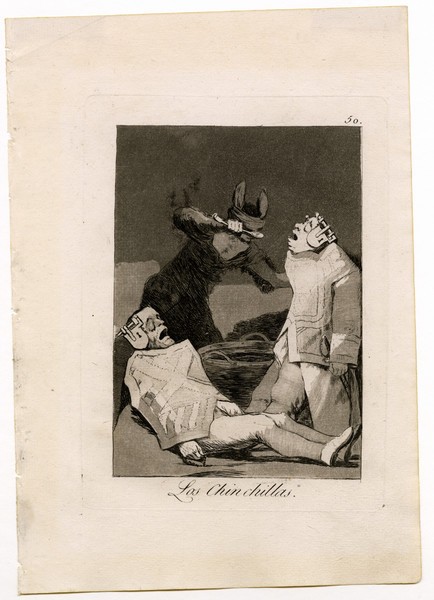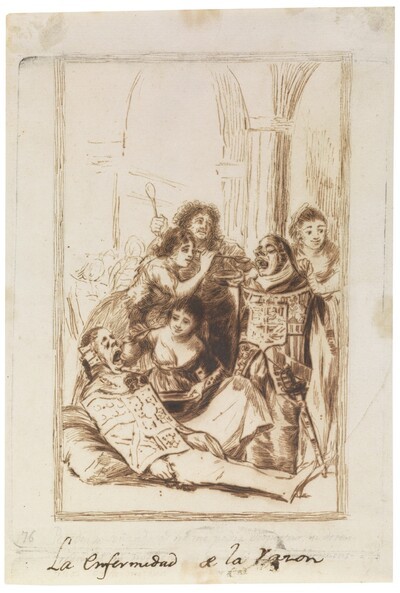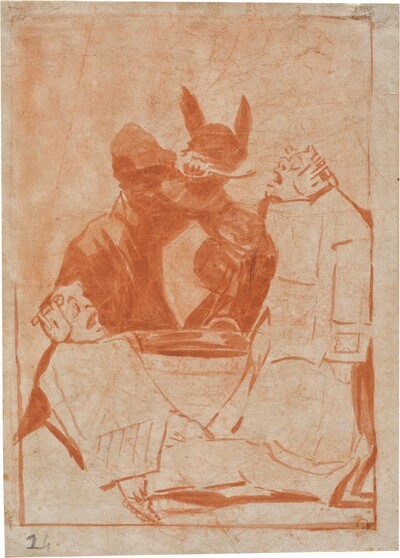- Cronología
- Ca. 1797 - 1799
- Dimensiones
- 207 x 151 mm
- Técnica y soporte
- Aguafuerte, aguatinta bruñida y buril
- Reconocimiento de la autoría de Goya
- Undisputed work
- Ficha: realización/revisión
- 20 Aug 2013 / 29 May 2024
- Inventario
- 225
Los Chinchillas. (at the bottom)
50. (in the upper right-hand corner)
See Francisco de Goya y Lucientes, Painter.
Two preparatory drawings for this engraving are preserved (1) and (2).
Two men, with gawking faces, appear immobilised and wrapped in stiff heraldic costumes. Their eyes are closed and their ears are covered by two thick padlocks. One of them is lying on the ground with a rosary in his hand, while the other is standing with a sabre. He is wearing a tabard of some sort underneath and something that hangs down to the ground, possibly an executioner's certificate. A strange figure, wearing donkey's ears and a blindfold, serves him a spoonful of food from a cauldron between the two Chinchillas. We cannot tell whether it is a man or a woman as, although his clothes look rather feminine, he has an incipient curly beard.
The Aragonese painter has created intense contrasts of light and shade, so that the Chinchillas are strongly illuminated, as are the hand and the spoon of Ignorance, the latter being decisive in emphasising the disability of the two figures.
In the manuscript of the National Library we find a very specific explanation for this engraving: "The foolish ones, precious as nobles, are always with their executoria at their breast, reclining desidiously, praying like fanatics the rosary and yawning. Ignorance feeds them coarsely and keeps their minds padlocked.
In this picture, Goya lashes out against those who flaunt their noble pride, against the corseted and blind aristocracy that is fed by Ignorance. However, this explanation does not quite justify the meaning of the title, to which Edith Helman seems to have found an answer. The specialist argues that Goya based his work on a popular comedy, El dómine Lucas, by José de Cañizares y Suárez (Madrid, 1676-1750). The painter was familiar with Cañizares's literary output as one of his patrons was the Duke of Osuna, for whom the painter produced a series of paintings between 1797 and 1798 to decorate his country house called The Caprice. For one of these works Flight of Witches, the Aragonese painter had already been inspired by this work by Cañizares.
In the book, the main character Lucas de Chinchilla and his uncle, Don Pedro de Chinchilla, belonged to a family attached to their aristocratic privileges and noble coats of arms, which made them believe they were superior to others. This work must have been very popular at the time, so that the public must have quickly understood the meaning of the title of this engraving.
The aquatint of the plate is somewhat weakened. (the National Chalcography, no. 221).
-
Goya. Gemälde Zeichnungen. Graphik. TapisserienKunsthalle BaselBasle1953from January 23th to April 12th 1953cat. 327
-
De grafiek van GoyaRijksmuseum RijksprentenkabinetAmsterdam1970from November 13th 1970 to January 17th 1971cat. 37
-
Goya. Das Zeitalter der Revolucionen. Kunst um 1800 (1980 – 1981)Hamburger KunsthalleHamburg1980cat. 36
-
Goya y el espíritu de la IlustraciónMuseo Nacional del PradoMadrid1988from October 6th to December 18th 1988. Exhibited also at Museum of Fine Arts, Boston, January 18th to March 26th 1989; The Metropolitan Museum of Art, Nueva York, May 9th to July 16th 1989, Madrid curator Manuela B. Mena Marqués, scientific directors Alfonso E. Pérez Sánchez and Eleanor A. Sayrecat. 55
-
Goya. La década de Los CaprichosMadrid1992organized by Real Academia de Bellas Artes de San Fernando sponsored by Fundación Central Hispano, Madrid, consultant editor Nigel Glendinnig. From October 26th 1992 to January 10th 1993cat. 121
-
Francisco de GoyaMuseo d'Arte ModernaLugano1996exhibition celebrated from September 22nd to November 17th.cat. 50, p.77
-
Francisco Goya. Sein leben im spiegel der graphik. Fuendetodos 1746-1828 Bordeaux. 1746-1996Galerie KornfeldBern1996from November 21st 1996 to January 1997cat. 56
-
Goya e la tradizione italianaFondazione Magnani RoccaMamiano di Traversetolo (Parma)2006consultant editors Fred Licht and Simona Tosini Pizzetti. From September 9th to December 3th 2006cat. 50, p.158
-
Goya. Opera graficaPinacoteca del Castello di San GiorgioLegnano2006exhibition celebrated from December 16th 2006 to April 1st 2007p.37
-
Goya et la modernitéPinacothèque de ParisParís2013from October 11st 2013 to March 16th 2014cat.8
-
Los Chinchillas de GoyaMadridFundación Lázaro Galdiano1955pp.162-167
-
Goya engravings and lithographs, vol. I y II.OxfordBruno Cassirer1964p.123, cat. 85
-
Vie et ouvre de Francisco de GoyaParísOffice du livre1970p.182, cat. 551
-
Goya, la década de los caprichos: dibujos y aguafuertesMadridReal Academia de Bellas Artes de San Fernando1992pp.202-205, cat. 119-121
-
Catálogo de las estampas de Goya en la Biblioteca NacionalMadridMinisterio de Educación y Cultura, Biblioteca Nacional1996p.100, cat. 139
-
El libro de los caprichos: dos siglos de interpretaciones (1799-1999). Catálogo de los dibujos, pruebas de estado, láminas de cobre y estampas de la primera ediciónMadridMuseo Nacional del Prado1999pp. 270-273
-
Goya. Die Kunst der FreiheitMunichVerlag C. H. Beck2000p.93, fig. 31
-
ParísPinacoteca de París2013p. 66
-
Goya. In the Norton Simon MuseumPasadenaNorton Simon Museum2016pp. 42-75


